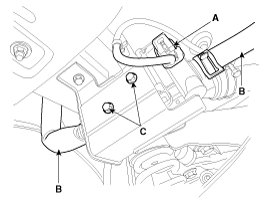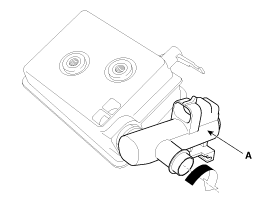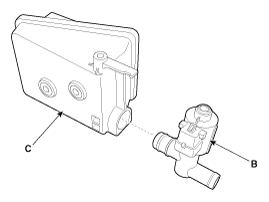 Hyundai Azera: Canister Close Valve (CCV) Repair procedures
Fifth generation HG (2011–2025) / Hyundai Azera 2011-2025 Service Manual / Engine Control/Fuel System / Engine Control System / Canister Close Valve (CCV) Repair procedures
Hyundai Azera: Canister Close Valve (CCV) Repair procedures
Fifth generation HG (2011–2025) / Hyundai Azera 2011-2025 Service Manual / Engine Control/Fuel System / Engine Control System / Canister Close Valve (CCV) Repair procedures
Fifth generation HG (2011–2025) / Hyundai Azera 2011-2025 Service Manual / Engine Control/Fuel System / Engine Control System / Canister Close Valve (CCV) Repair procedures
| Inspection |
| 1. |
Turn the ignition switch OFF. |
| 2. |
Disconnect the CCV connector. |
| 3. |
Measure resistance between the CCV terminal 1 and 2. |
| 4. |
Check that the resistance is within the specification.
|
| 5. |
Disconnect the vapor hose connected with the canister from the CCV. |
| 6. |
Connect a vacuum pump to the nipple. |
| 7. |
Ground the CCV control line and apply battery voltage to the CCV power supply line. |
| 8. |
Apply vacuum and check the valve operation.
|
| Removal |
| 1. |
Turn the ignition switch OFF and disconnect the battery negative (-) cable. |
| 2. |
Lift the vehicle. |
| 3. |
Disconnect the canister close valve connector (A). |
| 4. |
Disconnect the ventilation hose (B) from the fuel tank air filter and canister close valve. |
| 5. |
Remove the fuel tank air filter assembly after removing bolts (C).
|
| 6. |
Release the lever (A), and then separate the canister close
valve (B) from the fuel tank air filter (C) after rotating it in the
direction of the arrow in the figure.
|
| Installation |
| • |
Install the component with the specified torques. |
| • |
Note that internal damage may occur when the component is dropped. In this case, use it after inspecting. |
| 1. |
Installation is reverse of removal. |
 Canister Close Valve (CCV) Schematic Diagrams
Canister Close Valve (CCV) Schematic Diagrams
Circuit Diagram
...
See also:
Fuel Filter Repair procedures
Removal
1.
Remove the fuel pump.
(Refer to Fuel Delivery System - “Fuel Pump”)
2.
Disconnect the electric pump wiring connector (A) and the fuel sender connector (B).
3.
Remove the c ...
Front Seat Back Cover Repair procedures
Replacement
•
Use a plastic panel removal tool to remove interior trim pieces to protect from marring the surface.
•
Take care not to bend or scratch the trim and ...
Engine overheat
If your temperature gauge indicates overheating, you experience a loss of power,
or hear loud pinging or knocking, the engine is probably too hot. If this happens,
you should:
1. Pull off the road ...
Categories
Hyundai Azera Manuals
© 2011-2025 Copyright www.hgmanual.com




